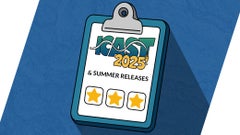Wesley Strader Wins at Kentucky Lake Bassmaster Elite
Wesley Strader's Winning Pattern, Baits and Gear
This victory was a long time coming for the Spring City, Tenn., native. He won an FLW Tour back in 2002 and a Bassmaster Open in 2016, but his latest triumph tops them all. "It took me four years to get an FLW Tour win," Strader said. "Here I am in my third tournament and I get a win on the Elites. It's just a weird feeling." What really helped it sink in was the "attaboys" he got from the rest of the finalists he'd just beaten. "What felt great was being congratulated by guys I look up to and respect like Skeet and those guys," Strader said.
Practice:
Strader said practice was "a grind," but he was encouraged by what he found each day. "I had five bites the first day, a pretty good day on day 2 and eight or nine bites on day 3 - the ones you'd want," he said. Day 1 was not very good, but the water was very high. I'd looked at the predicted elevations and knew it would fall, but I also knew it would stabilize around 359. "I knew things would get better just because there was so much water back in the bushes. That's not good because it eliminates places they can be." He had three focal points coming out of practice - the morning shad spawn as the water warmed through the 60s, docks and flooded bushes. "The water temperature threw me off in practice because I'd never seen it that low in the first week of May," he said. "It was 64-65 when we started and the highest I saw was 69 until Monday when I saw 75. It stayed relatively cool and I don't know if that factors into what's going on. I know the shad want it to be at 70 before they get busy spawning."
Competition:
Strader started strong with 19-03 on day 1, capitalizing on the shad spawn along a submerged roadbed. He had most of his weight by 10:30 that morning on a spinnerbait and buzzbait before going to check a pattern that had worked for him in the past. It didn't materialize this time around, which he says benefitted him in the long run. "That might've won the tournament for me because I went three hours without a bite so I said, 'I won't do that again,'" he said. "I never went back to it." He upgraded a couple times later in the day on a frog. The 17-13 he caught on day 2 was his smallest stringer, but he moved up five spots to 11th as several of the day-1 leaders struggled to catch limits under overcast and rainy conditions. The roadbed produced for him again in the morning before he flipped bushes later in the day. "I've known about the road bed for years," he said. "I'd never caught them there. It's a funnel in and funnel out spot and the shad were spawning there. When I checked it, lo and behold, they were there."
He also threw a frog some, but missed a bunch of fish that weren't committing to it. "I told myself that on day 3 I wouldn't do that until later in the day because it seemed as the warmer the water got they'd come up and get it," he said. The sun re-emerged on Sunday and Strader catapulted himself into the lead with a 22-06 stringer, the bulk of which was caught on a balsa crankbait around docks. A spinnerbait accounted for one keeper and a buzzbait accounted for another. "I caught everything on a crankbait under dock walkways, but by the end of the day, they'd moved from the walkways to the main floats," he said. "I usually catch them flipping the docks, but I couldn't catch them this week that way and I think it had a lot to do with the shad spawn." A frog accounted for a 5-13 upgrade later in the day to push his total past the 22-pound mark. On the final day, Strader fished with an open mind despite having his first Elite Series win within reach. He said he never pressed and kept his options open through the day. He caught an early limit on a spinnerbait, then fished docks and the nearby bushes and trees. The frog produced a keeper around some overhanging trees and his three biggest fish were caught in the matter of an hour flipping horizontal cover near bushes and willow trees.
"They say you never forget your first kiss," he said. "This is one of those days I'll never forget." After three events, he's getting used to the smaller field of the Elite Series. "Just the amount of boats that are not out there," he said. "It feels good to make a decision to go fish somewhere and there be a slim chance someone might be there. I never saw another boat all day except for the people who were following me." Of all the tournaments he's fished at Kentucky Lake, he said this was among the most challenging for several reasons. "What I don't understand is you either caught a keeper or didn't catch a fish," he said. "It's like there are no 13- to 15-inchers in the lake. I can count on one hand the short fish I caught all week. It's comforting, but unnerving at the same time because when you got bit you knew, more than likely, it's going to be a good one."
Winning Gear:
Spinnerbait gear: 7'5" medium-heavy Powell Endurance cranking rod, click here casting reel (6.8:1 ratio), 16-pound Gamma Edge fluorocarbon line, 5/8-oz. Stan Sloan's Zorro Bait Company Bango Blade spinnerbait (chartreuse white), Zoom Split Tail trailer (pearl white).
Flipping gear: 7'9" mag medium-heavy Powell Endurance casting rod, same reel (7.5:1 ratio), LINE, 5/16-oz. Reins Tungsten worm weight, 5/0 Lazer TroKar TK130 flippin hook, Zoom Z Hog (green-pumpkin), Reaction Innovations Sweet Beaver (tramp stamp).
He opted for the Sweet Beaver on the final day mainly because of the bait color matched up with the water color. "It was tannic color and that's the best color bait for that water color," he said.
Crankbait gear: Same rod as spinnerbait, same reel as spinnerbait, same line as spinnerbait, PH Custom Lures W Special crankbait (money).
Strader says the W Special is a hybrid square-bill plug that has a good in-between action (not too tight and not too wide). He said it will run down to four feet on 16-pound fluorocarbon.
Main factor: "Adjusting every day to what was going on. Just picking up the bait that's best suited for the situation you're in or the structure you're throwing at and just going with my gut. That was my main key to success."
Performance edge: "My HydroWave was a key Monday. I didn't run it around the docks because those were shad spawn fish. When I went to the bushes, I turned it on 45-second delay power pattern. It might not make them bite, but it masks your human noise. I had a lot of boats following me and I think it just relaxed those fish."
Bassmaster Tour Kentucky Lake Winning Pattern BassFan 5/9/18 (Todd Ceisner)
Skeet Reese's Pattern, Baits and Gear
"When the water was up, I'd fish the bushes, but they sucked the water out," he said. "Then I fished secondary stuff, but I didn't know that bite would die at 10:30 each day." He also targeted deeper channel swings that had "steeper contours instead of low, shallow, flat stuff," he said. He opted to use an array of bigger baits to mimic the gizzard shad that were spawning in the mornings. "I've won several times this time of year fishing big baits," he added. "With post-spawn fish and a population of fish in the 4- to 7-pound class, it set up perfectly for it. It's high risk if the conditions aren't right."
Gear:
Crankbait gear: 8' heavy-action Wright & McGill Skeet Reese Series casting rod, Wright & McGill Pro Series Elite casting reel (6.3:1 ratio), 20-pound Berkley Trilene 100% fluorocarbon line, Lucky Craft SKT Magnum 105 crankbait (chartreuse shad).
He also caught keepers on an assortment of other baits, including a hollow-belly Basstrix swimbait, a Berkley PowerBait tube, a Lucky Craft Slender Pointer and the 8" Megabass Mag Draft swimbait, acting on a tip from day-1 leader Chris Zaldain.
Main factor: "Once I got dialed in that there was a shad spawn bite and they were big shad, I knew bigger baits would work and that's where I have confidence. That's where the SKT Magnum came in. I knew I could go behind anybody and catch them. It also seemed like that bite started disappearing as the week went on."
Performance edge: "My Lowrance mapping was key to look for those little subtle indentations on the shoreline and points Ð that little place with deeper water. I could start calling my shots on day 2 that way."
Bassmaster Elite Tour Kentucky Lake 2-5 Patterns BassFan 5/10/18 (Todd Ceisner)
Kelley Jaye's Pattern, Baits and Gear
Jaye never picked up a flipping rod to target bushes. "Especially as the days went on and the water was dropping," he said. "They got beat to death. I knew I wouldn't do well." Instead, he focused on where fish were moving in and out of areas as they transitioned from pre- to post-spawn. "It was about trying to figure out where those fish would be relating, either going into the backs of creeks or pockets or out to the main channel," he said. "I tried to find stopping points along that route." Each fish, both pre- and post-spawners, was caught in 5 to 8 feet of water. He said the retrieve was pretty consistent across all four days. "It was mostly jerk-jerk-short pause," he said. "I was basically walking the dog under water."
Gear:
Jerkbait gear: 6'9" medium-action ALX Rods Kelley Jaye signature series casting rod, Team Lew's Pro Magnesium Speed Spool casting reel (7.3:1 ratio), 14-pound unnamed fluorocarbon line, Megabass Ito Vision 110 jerkbait (matte shad), Megabass Ito Shiner (custom color).
Main factor: "I stuck with what I had confidence in. I didn't hit the panic button and do crazy stuff. I just put my head down and made it work."
Bassmaster Elite Tour Kentucky Lake 2-5 Patterns BassFan 5/10/18 (Todd Ceisner)
Jason Christie's Pattern, Baits and Gear
In practice' the water levels were unnerving to him. It was inconsistent until the tournament got going. "On the first day' I kept telling myself the water needed to come down for it to be good'" he said. "The farther south I went the more flooded it seemed to be. Late on day 2' it got to about where it needed to be. Then on day 3' it was like' 'We don't have enough water.'" He thinks the amount of locals he saw targeting bushes was more an indication of how good the fishing had been with the high water as opposed to locals mimicking the pros. "What surprised me is I figured a lot more guys would be fishing other ways' but a lot of other guys were in the bushes'" he said. "That told me that in the previous couple weeks' the bush bite was probably good because everybody I saw was flipping bushes." He said bait presentation was critical to getting bites and staying confident in his approach. "There were two different kinds of bites'" he said. "I caught some on the outside' in the middle of the stuff and some lobbing over some bushes into the back. After day 1' the only thing in my mind was I had to get my bait where nobody else was putting theirs. I felt like every bush had been fished and no new fish were moving in so when I went down a row of bushes' I had to dig them out. I had to make a pitch way back or to where I felt nobody else had tried to flip."
He said when his bait dropped in where he felt nobody else had pitched before' he got bit on the initial fall. When he targeted the outside bushes' he tried to imagine where a bed would be in relation to the bush. "I'd just barely move it and they'd get it'" he said. He stayed in one creek for the duration of the tournament' short of a stretch on day 4 when he ran toward New Johnsonville to check something different. Overall' he enjoyed the style of fishing that the lake offered compared to his previous tournaments there. "I've done well on the ledge deal' but when you fish there it can be stressful because you spend three days idling and you don't dare make many casts because you don't want people to see you'" he said. "When those tournaments start' you've got 15 schools so you run to the best one. Maybe someone is on it' so then it's on to the next best one. At least this was a fishing tournament. Let's get the flipping stick out. Even though a grind it was kind of fun because it wasn't easy."
Gear:
Flipping gear: 7'3" heavy-action Falcon Cara T7 Amistad casting rod' Team Lew's Pro Magnesium Speed Spool casting reel (8.3:1 ratio)' 25-pound Sunline Shooter fluorocarbon line' 1/2-oz. unnamed tungsten worm weight' 5/0 Lazer TroKar TK 130 flippin hook' YUM Baits Christie Critter (green-pumpkin purple).
Christie had two identical Christie Critter rods set up' one with a black flipping weight and another with an unpainted weight.
Main factor: "I love when I can go flipping in an event. I don't have to worry about what rod to pick up. I just worry about the next bush. I had two or three rods laid out' but didn't make 10 casts with them."
Performance edge: "I could've have very well finished in the 40s or high 30s' but I just happened to be sitting there (Saturday night) and looked at a spot (on my Active Captain app). I saw it was tucked away and hard to get to. I went in there and caught five Sunday. That Active Captain app was a big key. It was the kind of stuff I was looking for Ð just those little bitty places that were being overlooked. The thing at Kentucky Lake is if you get in an area that hadn't been fished' they bite."
Bassmaster Elite Tour Kentucky Lake 2-5 Patterns BassFan 5/10/18 (Todd Ceisner)
Fred Roumbanis' Pattern, Baits and Gear
After junk-fishing the morning of day 1, he got more dialed in on the swimbait pattern that day. "To the point where it was the only rod I had on my deck," he said. It was a struggle to not try other things during lulls between bites. For instance, he amassed 18 pounds pretty quick on day 2 with his swimbait, then picked up a shakyhead and caught a couple smaller fish. "It was only 9 a.m., so I went back to the swimbait and caught a 3, then a 4," he said. "That's when it clicked that I needed to stick with that. It's nice to have a couple back-up plans, but it's more time consuming when you have more things to do." He focused on hard-bottom transition areas going into a creek where the fish would spawn. "It was the perfect interception point," he added. "Fish were going in and coming out and bait was there. I saw them on (Garmin) Panoptix. If I saw just a moving fish with no bait around, I assumed it was a carp. If I saw bait and it was getting pushed around, I knew those were bass. I saw a lot of that in that area." He estimated catching at least 10 4-pounders over the course of the tournament in that area.
"I knew when to lock down and fish a spot, especially when you get multiple solid bites in one area," he said. "You stick to it because there's probably more there." To change up his presentation, he learned three different casts to deliver the bait from a various angles. Most of the bites came out of 7 or 8 feet of water. "I rotated around based on the wind," he said. "I feel like I could go back there tomorrow and do it again."
Gear:
Swimbait gear: 7'11" heavy-action iRod Genesis II Fred's Crank Launcher casting rod, Cabela's Arachnid casting reel (8.0:1 ratio), 20-pound unnamed fluorocarbon line, 6" Optimum Baits Boom Boom (rigged) swimbait (ghost rider, ghost minnow, PB shad).
For his retrieve, Roumbanis had to reel at a painstakingly slow pace, especially with a 8.0:1 reel, which was necessary to pick up line on the hookset. "I had to crawl it," he said. "I'd make a long cast and snap it to get the tail going and then slowly crawl it."
Main factor: "Sticking to my guns and throwing my swimbait. It's one of my strengths and I probably have as much confidence as anybody on tour in that bait. Whenever I can get on that bite, it's usually a top-10 finish for me."
Performance edge: "That Garmin Pantopix is what gave me confidence to stick around. I saw the bait and since there was not much activity on the surface, I had to see where the fish were. There was a wolf pack of bass I was following. I could see the bait around the bass with Panoptix."
Bassmaster Elite Tour Kentucky Lake 2-5 Patterns BassFan 5/10/18 (Todd Ceisner)



























